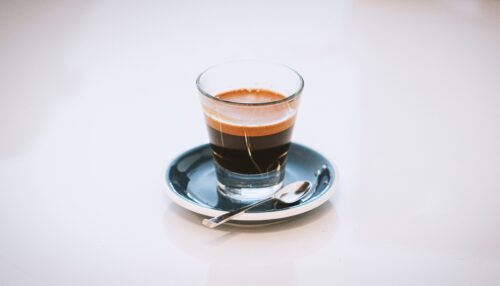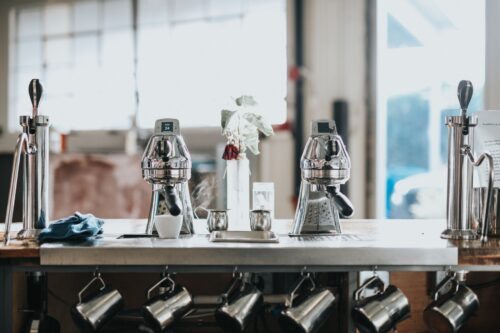To extract means to remove or obtain something, usually by a particular method.
In the case of coffee, we use water to extract, or remove, the parts of the coffee seed (bean) we want to drink—not every part of a coffee bean tastes good or is desirable. We do this at a specific rate, to a desired concentration, and to get the flavor we like.
Coffee seeds have many different compounds inside them. Using water, we aim to extract just the right amount of these compounds to get a tasty, balanced cup that’s neither too strong nor weak. Generally, the extraction yield is communicated as a percentage, which refers to how much of the coffee seed ends up in the finished product (“the cup”).
About 30 percent of roasted coffee is water soluble; target extraction ranges between 18 and 22 percent. Finding the balance between extracting enough of coffee’s soluble compounds to deliver complex flavor yet not going so far as to over-extract is challenging. An under-extracted cup can taste weak and dull, while an over-extracted cup can pull out undesirable, bitter notes.
Extraction is an incredibly complex process. Properly extracted coffee can be tied to several variables—here are a few basics to kickstart your extraction knowledge.
Freshness
You’ve probably read that the fresher a coffee, the better it is—but sometimes, coffee can be too fresh.

Freshly roasted coffee should undergo a period of aging that allows it to degas. Roasting creates carbon dioxide in the bean, which forms almost a protective layer around a newly roasted coffee. Gases from the roasting process eventually exit the pores of the bean over time, making it more permeable. Coffee not degassed sufficiently will be less permeable and challenging to extract.
Water Type
Water quality varies greatly depending on geographical origin, local water treatment, and in-house filtration systems. Water is full of dissolved minerals like calcium and magnesium, and you also need to consider the alkalinity, pH, and sodium levels.
All the variables above impact your extraction yield, so it’s important to know what’s in your brewing water.
Brew Ratio
Brew ratio refers to how much coffee is used for a given quantity of water, which may be expressed in either grams or ounces. A 1:16 coffee-to-water ratio is commonly recommended as a starting point, but you can experiment with ratios based on taste.
Grind Size
Imagine a whole bean of coffee. An entire bean has less surface area than a bean broken in half, which has less surface area than a bean divided in fourths, etc…
Grind size directly correlates to the amount of surface area you expose of a coffee bean and is controlled by the settings on your grinder. The smaller, or finer, the grind size, the more surface area there is, and the easier it is for water to extract flavor.
The opposite is also true: the coarser your ground coffee is, the less surface area there is. In addition to drastically affecting the coffee’s solubility—finer ground coffee is more soluble since there’s more surface area exposed—grind size also affects flow rate. Imagine water flowing through large boulders versus sand: water will take much longer to flow through the sand.
Temperature
Hot water extracts coffee flavor faster than cold water. That’s why cold brewing takes hours while hot brewing takes minutes.
However, too hot water can burn coffee grounds and lead to over-extraction. The Specialty Coffee Association generally considers the ideal brewing temperature to be between 195 and 205 degrees Fahrenheit.
Temperature stability throughout the brew cycle is desirable for replicable results, which is why you want your water to stay the same temperature throughout brewing. Just as baking foods at different temperatures will result in drastically different results, different brew temperatures will extract coffee differently.
Contact Time
The contact time refers to the length of time water and grounds interact. Too short = under-extracted; too long = over-extracted.
Bloom
The bloom usually refers to the first pour of water onto a dry bed of grounds. This phase prepares coffee for extraction by helping to release CO2 and allowing subsequently added water to move more freely through the bed of grounds.
Usually, baristas will bloom their coffee with about double the weight of their dose (if they’re brewing with 30 grams of coffee, the bloom is usually about 60 grams of water). An even pre-wetting should result in a more even extraction.
Strength/(TDS)
TDS (total dissolved solids) refers to the solids dissolved in the cup, not including crema or oils formed on the surface.
This is measured with a refractometer. TDS translates to the concentration of dissolved coffee solids in the cup and is described in terms of strength. The higher the concentration of TDS, the stronger the cup, and the lower the concentration of TDS, the weaker the cup.
In practice, strength is determined by how the coffee feels in your mouth. Strong cups feel thick or heavy, while weak cups feel thin or watery.
Agitation
This is the word we use for creating turbulence in coffee. You can do this with a spoon or with the water stream from the kettle.
Agitation directly relates to the extraction rate, so this variable should be kept consistent from brew to brew.
Flow Rate
The rate at which water flows through coffee.
Jennifer Haare is the director of training and staff development at Ipsento Coffee.
This article was originally published on August 21, 2017 and has been updated to reflect Fresh Cup’s current editorial standards.


















